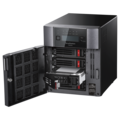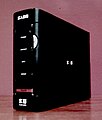Internet Small Computer Systems Interface or iSCSI is an Internet Protocol-based storage networking standard for linking data storage facilities. iSCSI provides block-level access to storage devices by carrying SCSI commands over a TCP/IP network. iSCSI facilitates data transfers over intranets and to manage storage over long distances. It can be used to transmit data over local area networks (LANs), wide area networks (WANs), or the Internet and can enable location-independent data storage and retrieval.

Network-attached storage (NAS) is a file-level computer data storage server connected to a computer network providing data access to a heterogeneous group of clients. The term "NAS" can refer to both the technology and systems involved, or a specialized device built for such functionality.

A disk enclosure is a specialized casing designed to hold and power hard disk drives or solid state drives while providing a mechanism to allow them to communicate to one or more separate computers.

The USB mass storage device class is a set of computing communications protocols, specifically a USB Device Class, defined by the USB Implementers Forum that makes a USB device accessible to a host computing device and enables file transfers between the host and the USB device. To a host, the USB device acts as an external hard drive; the protocol set interfaces with a number of storage devices.
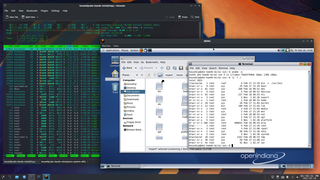
The Quick Emulator (QEMU) is a free and open-source emulator that uses dynamic binary translation to emulate a computer's processor; that is, it translates the emulated binary codes to an equivalent binary format which is executed by the machine. It provides a variety of hardware and device models for the virtual machine, enabling it to run different guest operating systems. QEMU can be used with a Kernel-based Virtual Machine (KVM) to emulate hardware at near-native speeds. Additionally, it supports user-level processes, allowing applications compiled for one processor architecture to run on another.

Direct-attached storage (DAS) is digital storage directly attached to the computer accessing it, as opposed to storage accessed over a computer network. DAS consists of one or more storage units such as hard drives, solid-state drives, optical disc drives within an external enclosure. The term "DAS" is a retronym to contrast with storage area network (SAN) and network-attached storage (NAS).
The NSLU2 is a network-attached storage (NAS) device made by Linksys introduced in 2004 and discontinued in 2008. It makes USB flash memory and hard disks accessible over a network using the SMB protocol. It was superseded mainly by the NAS200 and in another sense by the WRT600N and WRT300N/350N which both combine a Wi-Fi router with a storage link.

Time Machine is the backup mechanism of macOS, the desktop operating system developed by Apple. The software is designed to work with both local storage devices and network-attached disks, and is commonly used with external disk drives connected using either USB or Thunderbolt. It was first introduced in Mac OS X 10.5 Leopard, which was released in October 2007 and incrementally refined in subsequent releases of macOS. Time Machine was revamped in macOS 11 Big Sur to support APFS, thereby enabling "faster, more compact, and more reliable backups" than were possible previously.

Melco Holdings Inc. is a family business founded by Makoto Maki in 1975 and is located in Japan. The company's most recognizable brand is Buffalo Inc.

The AirPort Time Capsule is a wireless router which was sold by Apple Inc., featuring network-attached storage (NAS) and a residential gateway router, and is one of Apple's AirPort products. It is essentially a version of the AirPort Extreme with an internal hard drive. Apple describes it as a "Backup Appliance", designed to work in tandem with the Time Machine backup software utility introduced in Mac OS X 10.5.
IBM introduced Server-Free backup with IBM Tivoli Storage Manager 5.1 in 2002 for Windows 2000 servers only. Server-Free backup functionality were included in IBM Tivoli Storage Manager version 5.1, 5.2, and 5.3, but not in 5.4 or later, but are supported in 5.4 and later.

On Linux, network block device (NBD) is a network protocol that can be used to forward a block device from one machine to a second machine. As an example, a local machine can access a hard disk drive that is attached to another computer.

A storage area network (SAN) or storage network is a computer network which provides access to consolidated, block-level data storage. SANs are primarily used to access data storage devices, such as disk arrays and tape libraries from servers so that the devices appear to the operating system as direct-attached storage. A SAN typically is a dedicated network of storage devices not accessible through the local area network (LAN).
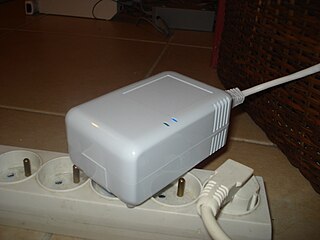
A plug computer is a small-form-factor computer whose chassis contains the AC power plug, and thus plugs directly into the wall. Alternatively, the computer may resemble an AC adapter or a similarly small device. Plug computers are often configured for use in the home or office as compact computer.

The SheevaPlug is a "plug computer" designed to allow standard computing features in as small a space as possible. It was a small embedded Linux ARM computer without a display which can be considered an early predecessor to the subsequent Raspberry Pi.

USB Attached SCSI (UAS) or USB Attached SCSI Protocol (UASP) is a computer protocol used to move data to and from USB storage devices such as hard drives (HDDs), solid-state drives (SSDs), and thumb drives. UAS depends on the USB protocol, and uses the standard SCSI command set. Use of UAS generally provides faster transfers compared to the older USB Mass Storage Bulk-Only Transport (BOT) drivers.

Thecus Technology Corporation (Thecus) is a Taiwanese multinational corporation that designs and markets Network-Attached Storage (NAS), Direct-attached storage (DAS), and Network Video Recorders (NVRs). Thecus is best known for producing NAS and creates and designs its own hardware, firmware, and accessory software. Thecus's products are distributed worldwide and localized in several languages. Thecus's headquarters are located in Taipei, Taiwan with subsidiaries located around the world.

The Linux-IOTarget (LIO) is an open-source Small Computer System Interface (SCSI) target implementation included with the Linux kernel.
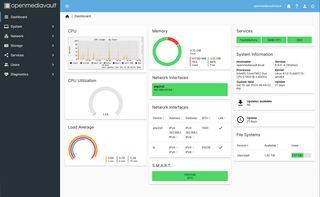
OpenMediaVault (OMV) is a free Linux distribution designed for network-attached storage (NAS). The project's lead developer is Volker Theile, who instituted it in 2009. OMV is based on the Debian operating system, and is licensed through the GNU General Public License v3.

XigmaNAS is an open-source Network-attached storage (NAS) server software with a dedicated management web interface. It is a continuation of the original FreeNAS code, which was developed between 2005 and late 2011. It was released under the name NAS4Free on 22 March 2012. The name was changed to XigmaNAS in July 2018. On SourceForge, it was elected "'Community Choice' Project of the Month" twice, in August 2015 and March 2017.

